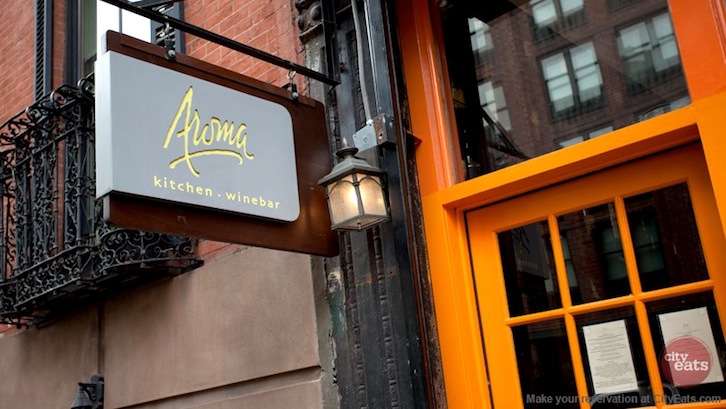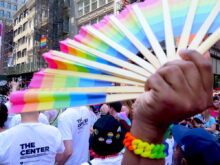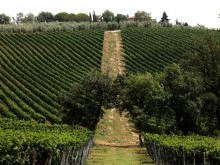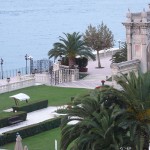There’s a small ristorante a Roma, not so far from the Hotel de Russie, a short walk from the Spanish steps. A ristorante you discovered your first time to the Eternal City. You were given its name on a slip of paper by a member of the American Academy in Rome. Only locals dined there; no English was spoken by the waiters. And that meal you enjoyed that night – the arancini, the fiori di zucca, the risotto – has fueled your culinary fantasies ever since. Alas, you’ve misplaced the address and on subsequent trips to Roma, you’ve searched in vain…
And then, one early spring night, you find yourself entering a small ristorante on Fourth Street in the East Village in New York – and suddenly, you’re transported back to your first love affair with the Eternal City.
The restaurant is called Aroma Kitchen & Winebar and its warm, inviting ambiance envelops you as soon as you cross the threshold. A cozy space with a rustic birch wood bar (perfect for dining alone or a due), illuminated by softly-glowing chandeliers and candles, Aroma feels like the romantic country home of an urbane and sophisticated gourmand- and the convivial atmosphere immediately makes you feel like a welcomed guest.
In opening Aroma Kitchen & Winebar in March 2005, owner/chef Vito Polosa (originally from a town south of Naples) and his wife Alexandra (a native of Malta) fused their childhood memories of Mediterranean cuisine and culture to create an Italian sanctuary marked by fresh local food matched with excellent Italian wines- in a setting both relaxing and stimulating.
With a background at some of New York’s most well-reviewed and popular restaurants (including Da Silvano and Fiamma), as well as a stint as wine rep at Winebow, Polosa has a deep hospitality background- and a recent five-course tasting menu (offered every Monday evening for $35 per person; the optional $25 wine pairing is highly recommended – it comes from Polosa’s extensive collection of more than 150 Italian wines) was a testament to the success of his and his wife’s dream.
The harmonic convergence of food, wine, and conviviality
To start, there was an amuse-gueule of two tangles of spaghetti: the first, fried in oil and served with a charred Colombian pepper, was fiery, a wake-up call to the palate – while the second tangle was an unctuous combination of cream, mushrooms, and shaved black truffles- and precisely the sort of toothsome opener that inspires unequivocal trust in the chef. House-cured Cerignola olives gave off a whiff of fennel, while the fresh bread begged for a bath in the Ligurian olive oil.
Equally as ambrosial as the food were the pairings of wine with each course, chosen judiciously to complement flavors on the plate. With a generous pour to insure a sip with every bite (and served in splendid Riedel stemware), the wines included aCantina de Negrar Valpolicella Classico 2008 – exquisitely dry with a spicy finish – and a splendidly ashy and cherry Etna Rosso Terre Nere 2008 that perfectly mirrored the earthiness of the roasted beets tartare served with avocado, fennel, and fontina.
The third course – mezzaluna pasta filled with beets – was served in a brown butter and sage sauce; a dish that was so transcendent as to serve as a catalyst for a conversation about the very best plates of pasta eaten throughout Italy. This ethereal treat was paired with a glass of Geografico Pulleraia 2003, a terroir merlot lined by fruits and violets – and the richness of the butter and pasta, underscored by the sweet beets, all complemented by the Pulleraia’s fulsome bouquet was a definitive example of the harmonic convergence of food and wine.
Two subterranean rooms are the very definition of a private enoteca
In truth, the deal was sealed – and yet there was another course, another glass, and another birthday at another table- at which point the entire dining room burst into song, in Italian and English, and toasted to the celebrant. How could one not feel a part of the family all gathered together under the roof of Vito and Alex?
Downstairs, via a narrow staircase and through a series of labyrinthine catacomb-like pathways, there are two more dining rooms, one called The Farmhouse, and the other La Tavernetta (seating 22 and 12, respectively). Lined with wine bottles and shadowed with candlelight, these two rooms are the very definition of a private enoteca. Romantic and secluded-it’s no wonder that these rooms are habitually booked solid on Valentine’s night.
For dessert we ate blackberry and lemon crostata, and gelato, alongside a glass of Cantine Federiciane Gragnano 2009 that burst with a kind of raspberry sweet and sourness, while up near the front of Aroma, a man commenced playing the Spanish guitar. Suffused with the glow of good food, wine, and song – these are the moments of which marriage proposals are made.
Even at meal’s end, you find yourself lingering at Aroma Kitchen & Winebar – ordering an espresso, another glass of wine – because Vito and Alex have taken you into their home- and back to that small ristorante you remember with such fondness from your first night in Roma.
GENERAL INFORMATION
Aroma Kitchen & Winebar
36 East Fourth Street (between Bowery and Lafayette), New York City
212.375.0100
Website: Aroma Kitchen & Winebar
Sunday through Thursday, 5 pm – 12 am
Friday / Saturday: 5 pm – 1 am
Mondays: Tasting Menu / $35 per person / $25 wine pairing
Tuesdays: Frugal Feast / $32 two-course chef menu plus wine
Sundays: Social Sundays / three courses for $25






